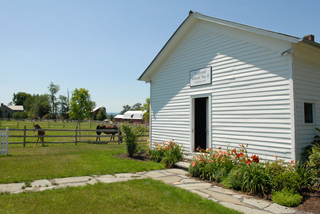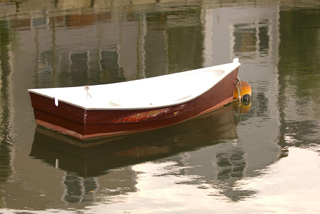I have been shooting digitally since February 1999; starting with a point-and-shoot Agfa ePhoto 780. It was a sub 1MP camera (350,000 pixels to be exact) and cost $400. This was around the time of the Kodak DCS500 series (built around the Canon EOS-1) and the DCS600 series (built around the Nikon F5). It's amazing how far we've come in just a short amount of time. From a long time before that I've been a computer geek, and a Macintosh die hard. I had fiddled around with Photoshop, but didn't do too much. Macromedia Fireworks was a program I used a lot in that timeframe. It was great for batch resizing images, which at the time wasn't too easy to do in Photoshop (at least I didn't know how to do it)!
 Anyway, digital was always many steps behind film
back then. Digital wasn't considered serious by many except at
newspapers. It was just considered quick and easy. Film was for all my
real work and digital was for snapshots and webpages. A hybrid workflow
was to scan my film. For a long time I followed the
endless debates of film versus digital and I must admit I was one of
those diehards who could not ever imagine digital being "better" than
film. Stupid. I struke a compromise by buying a Minolta film
scanner. But that was a real pain! And was only 35mm. Then I started
getting PhotoCDs with every film processing. All this was a real pain
too. The lab was in the middle of Boston, a train ride away from work.
My end product was great: I'd get amazing 16x20 prints from professional
scans, but at great cost.
Anyway, digital was always many steps behind film
back then. Digital wasn't considered serious by many except at
newspapers. It was just considered quick and easy. Film was for all my
real work and digital was for snapshots and webpages. A hybrid workflow
was to scan my film. For a long time I followed the
endless debates of film versus digital and I must admit I was one of
those diehards who could not ever imagine digital being "better" than
film. Stupid. I struke a compromise by buying a Minolta film
scanner. But that was a real pain! And was only 35mm. Then I started
getting PhotoCDs with every film processing. All this was a real pain
too. The lab was in the middle of Boston, a train ride away from work.
My end product was great: I'd get amazing 16x20 prints from professional
scans, but at great cost.
Fast-forward all the way to late 2006. I had been chugging away this way for a long time and by that time was using a whopping 2MP digital camera (the HP PhotoSmart 912C). By this time, digital had become serious and I realized film's limitations most notably in processing time and lack of control over the final print. For film I was still using all manual 35mm and medium format cameras. There was no such thing as autofocus for me which made sports a real pain!
Well, December 2006 during Christmas break I finally took the plunge. I went with the Nikon brand over Canon even though Canon had the full-frame 5D as an option. Why did I do that? Simple reasons: I felt the build quality of the D200 was much better than the 5D (this was the market I was in, not the 1Ds or D2X market) and I felt Nikon was an underdog, at least in the pro market. I like underdogs, hence my Apple fixation and recent joys of how they have grown their products. I shot about 35K frames between January 1 and late November 2007. Then I sold both cameras and upgraded to two D300 cameras the day they were released for the improved high ISO performance and much better autofocus that I needed for sports.
My gear currently includes: Two Nikon D300 camera bodies, one MB-D10 grip (complete with the BL-10, EN-EL4a, and MH-21 accessories), SB-600 and 800 flashes with SU-800 commander, Custom Brackets Digital Pro E (for events) and Really Right Stuff B91-B (for sports) brackets, Photogenic stands, umbrellas and 40" softbox, JTL background stand, seamless papers, various muslins, and 52" white/gold collapsible reflectors. I also use Alien Bees B800 studio lights with radio triggers. I meter my lighting carefully with a Shepherd Polaris meter: the second oldest piece of my gear.
 I have also collected a bunch of lenses: Nikkor
17-55/2.8, 35/2, 50/1.4, 85/1.8, 70-200/2.8 VR with Really Right Stuff
foot, 300/4 AF-S with Really Right Stuff collar and foot, TC-14E II
teleconverter, Tokina 12-24/4 super wide angle, and Tamron 90mm/2.8 DI
Macro lenses. I use screw-in B+W UV or Hoya Digital Pro protectors and a
B+W slim circular polarizer. I don't use graduated neutral density
filters anymore (read below). I experimented a little when settling on
lenses. There were several buy, try, sells in there over a period of
several months. I didn't care for the Sigma 50-150/2.8 or the
18-50/2.8. They were both slower focusing than the Nikon equivalent,
weren't close to the same build quality, and were smaller and lighter.
I tend to like big and heavy. Optically, the 70-200 is better. The
wide-to-normal lenses were close in image quality from both Sigma and
Nikon, so it's a good bang-for-the-buck lens.
I have also collected a bunch of lenses: Nikkor
17-55/2.8, 35/2, 50/1.4, 85/1.8, 70-200/2.8 VR with Really Right Stuff
foot, 300/4 AF-S with Really Right Stuff collar and foot, TC-14E II
teleconverter, Tokina 12-24/4 super wide angle, and Tamron 90mm/2.8 DI
Macro lenses. I use screw-in B+W UV or Hoya Digital Pro protectors and a
B+W slim circular polarizer. I don't use graduated neutral density
filters anymore (read below). I experimented a little when settling on
lenses. There were several buy, try, sells in there over a period of
several months. I didn't care for the Sigma 50-150/2.8 or the
18-50/2.8. They were both slower focusing than the Nikon equivalent,
weren't close to the same build quality, and were smaller and lighter.
I tend to like big and heavy. Optically, the 70-200 is better. The
wide-to-normal lenses were close in image quality from both Sigma and
Nikon, so it's a good bang-for-the-buck lens.
For primes, I settled on the 85/1.8 because I usually shoot that focal length with the 70-200/2.8 for tight portraits and I didn't see the need for the expense of the 1.4 lens. I generally use the prime lenses for studio work or when I'm challenging myself to find images at a fixed focal length. The 85mm is used exclusively for studio or sports, the 50/1.4 and 35/2 are used for studio and really dark places like band concerts where I can move around and get the shot or dark gyms. The 300/4 I use almost exclusively for sports. It's invaluable and it weighs about as much as the 70-200, but significantly less cost than the 300/2.8. I've really never needed f/2.8 at 300mm. The 1.4X TC I rarely use, but it's in the bag when I bring the tele lenses just in case. The 12-24 is an especially nice focal length range for DX cameras.
 Learning how to shoot digitally on a professional DSLR is on the camera body.
I rarely use Auto ISO. I think it's cheating. But if you want to you
can. I suggest you don't because then you will get addicted to cheating
= not good and leads to sloppiness.
Learning how to shoot digitally on a professional DSLR is on the camera body.
I rarely use Auto ISO. I think it's cheating. But if you want to you
can. I suggest you don't because then you will get addicted to cheating
= not good and leads to sloppiness.
That's all you have to remember. Try not to go higher than ISO 1600. But if you must, you can boost to 3200 and get acceptable images. If you learn those three things that's 90% of getting a good exposure. I would NOT worry about spot or center metering. Choose subjects that don't have a differences in light (like a group where half the group is in dark shade and the other half is in bright sun). Since digital costs essentially nothing, you can afford to screw up a bunch and still have a lot of keepers. This is the great advantage to digital. It's addicting also. It can also be a justification to get sloppy with technique. But you won't fall for that!
Move focus selector to where you want it (by looking in the viewfinder). Press shutter halfway = focus. Keep going = shoot.
Once you shoot, if you must you can look at your image on your really nice LCD. All you do after a shot is hit the PLAY button to the left of the trash can icon.
The only other thing you need to know is that the meter will only stay on so long. When it goes off you cannot change the aperture or change focus point or see any settings in viewfinder. So, you just hold down the shutter button halfway and you're all set. I got stuck with this when I got started. Now you won't. It takes a small getting used to. But once you do it's muscle memory.